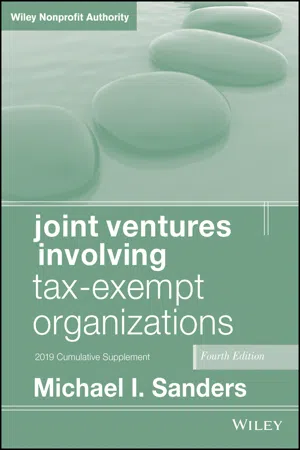
Joint Ventures Involving Tax-Exempt Organizations, 2019 Cumulative Supplement
2019 Cumulative Supplement
- English
- ePUB (mobile friendly)
- Available on iOS & Android
Joint Ventures Involving Tax-Exempt Organizations, 2019 Cumulative Supplement
2019 Cumulative Supplement
About This Book
Effective strategies for non-profit entities in a profit-based world
Joint Ventures Involving Tax-Exempt Organizations examines the procedures, rules, and regulations surrounding joint ventures and partnerships, emphasizing tax-exempt status preservation. Revised and updated to align with changes made to numerous tax codes and laws within the last year, this supplement offers expert interpretation and practical guidance to professionals seeking a complete reference, including an analysis of impact of the "siloing" of the UBIT rules, the new Opportunity Zone Funds which will incentivize investors in designated census tracts, inter alia. Sample documents enable quick reference and demonstrate real-world application of new laws and guidelines. The discussion delves into planning strategies that can be applied to joint ventures and partnerships while maintaining tax-exempt status, and which joint ventures are best suited for a particular organization.
Widely accepted business strategies for profit-based entities, joint ventures, partnerships, and alliances are increasingly being used by nonprofits in need of additional financial support in challenging economic environments. This book provides invaluable guidance to appropriate planning and structuring while complying with tax-exemption guidelines.
- Identify the most appropriate transactions for nonprofit organizations
- Recognize potential problems stemming from debt restructuring and asset protection plans
- Reference charitable organization, partnerships, and joint venture taxation guidelines
- Understand which joint venture configurations are best suited to tax-exempt organizations
Joint ventures and partnerships are currently employed by a variety of not-for-profit organizations while maintaining their tax-exempt status. Hospitals, research laboratories, colleges and universities, charter and special-needs schools, low-income housing developments, and many others are reaping the benefits of joint venture participation—but without careful planning and accurate interpretation of current laws, these benefits can be erased by loss of tax-exempt status. Joint Ventures Involving Tax-Exempt Organizations provides practical, up-to-date guidance on realizing the full benefits and avoiding the hazards unique to nonprofit organizations.
Frequently asked questions
Information
CHAPTER 1
Introduction: Joint Ventures Involving Exempt Organizations
- § 1.4 University Joint Ventures
- § 1.5 Low-Income Housing and New Markets Tax Credit Joint Ventures
- § 1.6 Conservation Joint Ventures
- § 1.8 Rev. Rul. 98-15 and Joint Venture Structure
- § 1.10 Ancillary Joint Ventures: Rev. Rul. 2004-51
- § 1.14 The Exempt Organization as a Lender or Ground Lessor
- § 1.15 Partnership Taxation
- § 1.17 Use of a Subsidiary as a Participant in a Joint Venture
- § 1.22 Limitation on Private Foundation's Activities That Limit Excess Business Holdings
- § 1.24 Other Developments
§ 1.4 UNIVERSITY JOINT VENTURES
§ 1.5 LOW-INCOME HOUSING AND NEW MARKETS TAX CREDIT JOINT VENTURES
§ 1.6 CONSERVATION JOINT VENTURES
§ 1.8 REV. RUL. 98-15 AND JOINT VENTURE STRUCTURE
§ 1.10 ANCILLARY JOINT VENTURES: REV. RUL. 2004-51
§ 1.14 THE EXEMPT ORGANIZATION AS A LENDER OR GROUND LESSOR
§ 1.15 PARTNERSHIP TAXATION
(a) Overview
Table of contents
- Cover
- Table of Contents
- Preface
- Acknowledgments
- CHAPTER 1: Introduction: Joint Ventures Involving Exempt Organizations
- CHAPTER 2: Taxation of Charitable Organizations
- CHAPTER 3: Taxation of Partnerships and Joint Ventures
- CHAPTER 4: Overview: Joint Ventures Involving Exempt Organizations
- CHAPTER 5: Private Benefit, Private Inurement, and Excess Benefit Transactions
- CHAPTER 6: Engaging in a Joint Venture: The Choices
- CHAPTER 7: Exempt Organizations as Accommodating Parties in Tax Shelter Transactions
- CHAPTER 8: The Unrelated Business Income Tax
- CHAPTER 9: Debt-Financed Income
- CHAPTER 10: Limitation on Excess Business Holdings
- CHAPTER 12: Healthcare Entities in Joint Ventures
- CHAPTER 13: Low-Income Housing, New Markets, Rehabilitation, and Other Tax Credit Programs
- CHAPTER 14: Joint Ventures with Universities
- CHAPTER 15: Business Leagues Engaged in Joint Ventures
- CHAPTER 16: Conservation Organizations in Joint Ventures
- CHAPTER 17: International Joint Ventures
- CHAPTER 19: Debt Restructuring and Asset Protection Issues
- Index
- End User License Agreement